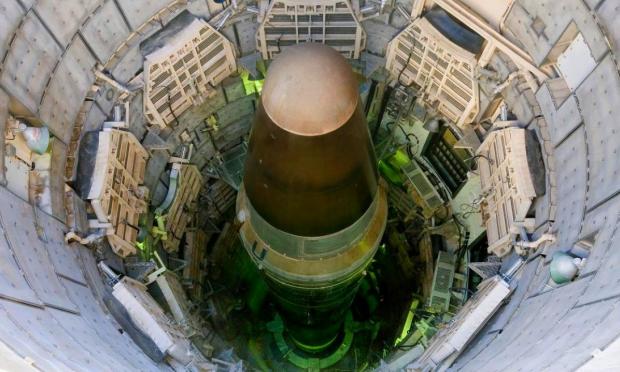The war in Ukraine has resulted for the first time in Russia seriously considering the use of tactical nuclear weapons on the battlefield, with very senior officials of the country, including first and foremost Vice President Medvedev, repeatedly warning from the beginning of the war that the red button of nuclear Armageddon would be pressed.
The Russians use a simulator to study the effects of a ground-based nuclear explosion on combat troops
The issue is revisited with a bombshell revelation by a highly respected International media outlet, which notes:
"Russia has reportedly developed an advanced simulator for ground-based nuclear explosions, designed to provide a visual simulation of key visual indicators, including the shock wave, radiation and mushroom cloud resulting from a ground-based nuclear explosion.
Russian scientists at the Military Staff College, named after General A.V. Khrulev, have developed a cutting-edge simulator for ground-based nuclear explosions, according to the state media agency TASS.
This recently patented simulator is designed to revolutionize the training of military units, particularly those within ground forces, for combat operations in environments involving the use of nuclear weapons.
The patent describes the primary objective of the simulator as providing a realistic visual representation of critical elements associated with a ground-based nuclear explosion,
The technology is ready to be integrated into military unit and training exercises.
This has the potential to substantially improve the readiness of ground forces for engagements in nuclear weapons scenarios.
In addition, the application of the simulator extends to radiation specialist units.
The report suggests that it will play a vital role in improving the capabilities of these units by helping to determine the parameters of an explosion and enabling accurate localisation of the epicentre.
The patent documentation highlights that the new simulator addresses the limitations of its predecessor, the IU-59 nuclear explosion simulator, which has become obsolete and is no longer in production.
Existing IU-59 samples in military depots have also reached the end of their technical lifetime, making them unsuitable for operational use.
In addition, the patent document sheds light on another alternative previously considered, the IAB-500 knock-off bomb.
However, this option was considered impractical due to its limited scope and the significant economic challenges associated with its use for training military units in radiation, chemical and biological detection.
"In addition, the IAB-500 model was retired from service in 1984 and is no longer produced by industrial firms," the report states.
Russia's nuclear readiness and the confrontation with the US
Moscow's presentation of an advanced simulator for ground-based nuclear explosions took place against the backdrop of heightened tensions with the US-led NATO.
This comes days after Russia rejected a US proposal to resume nuclear arms control talks, citing the difficult environment created by continued US support for Ukraine.
Foreign Minister Sergei Lavrov deemed the proposal to resume negotiations as "unacceptable", stressing the need for Washington to reassess its stance on Russia's conflict with Ukraine before meaningful talks can take place.
The disagreement over the renewed talks raises concerns about a possible new arms race, especially as the New START treaty, signed by former presidents Barack Obama and Dmitry Medvedev in 2010, is scheduled to expire in 2026.
The treaty places restrictions on US and Russian nuclear weapons and allows for on-site inspections to verify compliance. However, these inspections were halted in 2020 due to the COVID-19 pandemic and have not yet resumed.
Last February, Russian President Vladimir Putin suspended Russia's participation in the START treaty, citing perceived "hypocrisy and cynicism" by the US and NATO regarding their support for Ukraine.
As the Biden administration continues its unwavering support for Ukraine, providing billions in aid, it faces opposition from some Republicans in Congress who are demanding a link between foreign aid and tougher border policies.
Meanwhile, the introduction of the ground-based nuclear explosion simulator marks a major improvement in training Russian soldiers for combat operations in nuclear weapons scenarios.
In the context of the ongoing conflict with Ukraine, Moscow is demonstrating the readiness of its nuclear forces.
In October 2023, Russia conducted "massive" nuclear attack retaliation exercises involving missile launches from land-based silos, nuclear submarines and long-range bombers, all under the supervision of President Vladimir Putin.
The exercises were intended to practice responding to a hypothetical enemy-initiated nuclear strike, demonstrating Russia's strategic offensive capabilities.
The importance of non-strategic nuclear weapons for Russia
On the other hand, a leading Western think tank, the International Institute for Strategic Studies (IISS), observed that the ongoing war in Ukraine has undermined Russia's confidence in its conventional military capabilities.
This change in perception has elevated the importance of non-strategic nuclear weapons (NSNW) for Moscow, which are emerging as a key strategy for both deterring and countering NATO in potential future conflicts.
Russian tactical nuclear weapons targets in Ukraine
The use of tactical nuclear weapons on the battlefield is done in order to serve military purposes, such as, if necessary, the disruption of the enemy's defensive position, the destruction of his forces either in line or in reserve, as well as the prohibition of his use of a specific direction either to counterattack or to reinforce his forward units.
Our assessment is that Putin will not resort to the use of tactical nuclear weapons barring a spectacularly unexpected development.
In such a case, although we consider it very extreme, he could resort to the use of a low-power tactical nuclear weapon, causing either an airborne high explosion aimed at destroying Ukrainian telecommunications, or a surface or airborne low explosion of very low power, in an area evacuated by the civilian population, in the back of the Ukrainian combat units in the line of battle, prohibiting the use of the area by the Ukrainian reserves.



